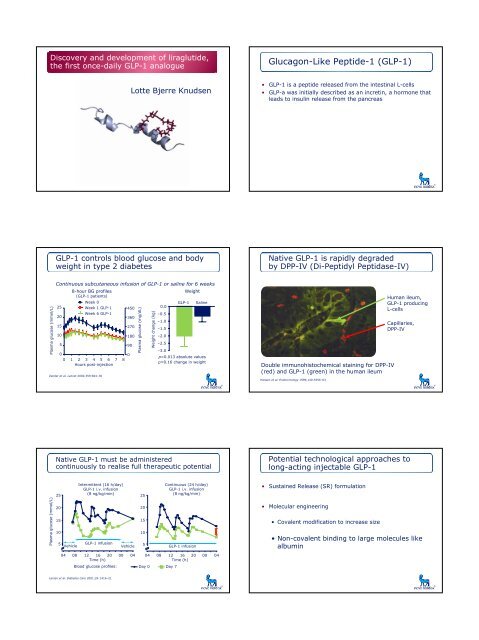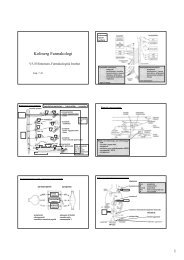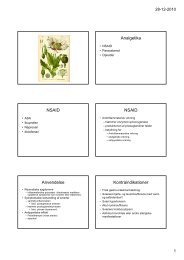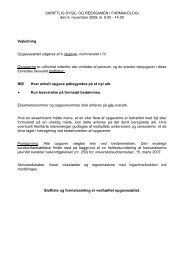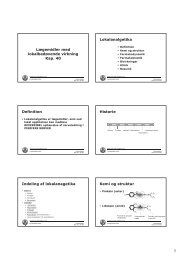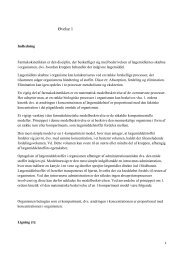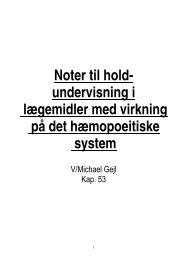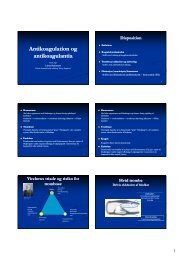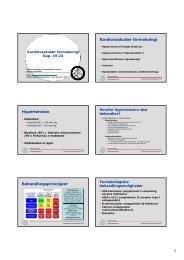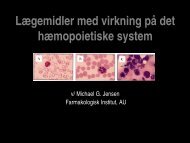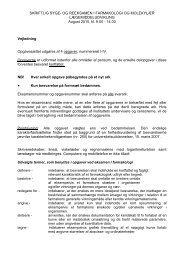Glucagon-Like Peptide-1 (GLP-1)
Glucagon-Like Peptide-1 (GLP-1)
Glucagon-Like Peptide-1 (GLP-1)
Create successful ePaper yourself
Turn your PDF publications into a flip-book with our unique Google optimized e-Paper software.
Discovery and development of liraglutide,the first once-daily <strong>GLP</strong>-1 analogueLotte Bjerre Knudsen<strong>Glucagon</strong>-<strong>Like</strong> <strong>Peptide</strong>-1 (<strong>GLP</strong>-1)• <strong>GLP</strong>-1 is a peptide released from the intestinal L-cells• <strong>GLP</strong>-a was initially described as an incretin, a hormone thatleads to insulin release from the pancreas<strong>GLP</strong>-1 controls blood glucose and bodyweight in type 2 diabetesNative <strong>GLP</strong>-1 is rapidly degradedby DPP-IV (Di-Peptidyl Peptidase-IV)Plasma glucose (mmol/L)Continuous subcutaneous infusion of <strong>GLP</strong>-1 or saline for 6 weeks25201510508-hour BG profiles(<strong>GLP</strong>-1 patients)Week 0Week 1 <strong>GLP</strong>-1Week 6 <strong>GLP</strong>-10 1 2 3 4 5 6 7 8Hours post-injectionZander et al. Lancet 2002;359:824–30450360270180900Plasma glucose (mg/dL)Weight change (kg)Weight<strong>GLP</strong>-1 Saline0.0–0.5–1.0–1.5–2.0–2.5–3.0p=0.013 absolute valuesp=0.16 change in weightDouble immunohistochemical staining for DPP-IV(red) and <strong>GLP</strong>-1 (green) in the human ileumHansen et al. Endocrinology 1999;140:5356–63Human ileum,<strong>GLP</strong>-1 producingL-cellsCapillaries,DPP-IVNative <strong>GLP</strong>-1 must be administeredcontinuously to realise full therapeutic potentialPotential technological approaches tolong-acting injectable <strong>GLP</strong>-1Plasma glucose (mmol/L)252015105VehicleIntermittent (16 h/day)<strong>GLP</strong>-1 i.v. infusion(8 ng/kg/min)<strong>GLP</strong>-1 infusionVehicle25201510Continuous (24 h/day)<strong>GLP</strong>-1 i.v. infusion(8 ng/kg/min)<strong>GLP</strong>-1 infusion04 08 12 16 20 00 04 04 08 12 16 20 00 04Time (h)Time (h)Blood glucose profiles: Day 0 Day 75• Sustained Release (SR) formulation• Molecular engineering• Covalent modification to increase size• Non-covalent binding to large molecules likealbuminLarsen et al. Diabetes Care 2001;24:1416–21
Alanine scan show what amino acids areessential for activitySimple DPP-IV stabilized position 8 analoguesmay be potent but are still cleared rapidlyPosition <strong>GLP</strong>-1R <strong>GLP</strong>-1RDPP-IVIle 29 25±3 0.01 IC 50 (nM) Relative(%)Glu Gly PheHis Ala Thr Thr Ser<strong>GLP</strong>-1(7-37) 0.27±0.09 1Asp7 9ValHis7 30±5 0.009SerLys Ala Ala Gln Gly Glu Leu Tyr SerGly10 59±4 0.005 GluPhe12 36±2 0.00837PheIle Ala Trp Leu Val Lys Gly Arg GlyThr13 36±6 0.008Asp15 11±1 0.02Phe28 351±49 0.0008Adelhorst, Hedegaard, Bjerre Knudsen & Kirk, J.Biol.Chem 1994;269(9):6275-6278Analogue <strong>GLP</strong>-1R N-terminal C-terminal DPP-IVIC 50 (nM) t½ (min) t½ (min)His Ala Glu Gly ThrPheThr Ser Asp<strong>GLP</strong>-1(7-36)NH 20.78±0.29 0.09±0.06 4.1±0.27 9ValThr 8 Ser(7-37) 49±3.7 3.9±0.2 4.2±0.4Lys Ala Ala Gln Gly Glu Leu Tyr SerSer 8 Glu(7-36)NH 29.0±1.9 3.7±0.4 4.2±0.2Phe37Gly 8 Ile Ala Trp Leu Val Lys Gly Arg Gly(7-37) 2.8±0.42 3.3±0.4 3.5±0.7Aib 8 (7-37) 0.45±0.05 - 4.4±0.2Deacon, Bjerre Knudsen, Madsen, Wiberg, Jacobson & Holst, Diabetologia 1998;41:271 278Human serum albumin binds fattyacids naturally<strong>GLP</strong>-1 may be acylated at multiple sitesresulting in once-daily pharmacokineticsAnalogue Acyl site Substituent Potency (pM) t½ (h), pigs<strong>GLP</strong>-1(7-37) 55 ±19 1.2K 18 R 26,34 -<strong>GLP</strong>-1 K 18 γ-Glu-C16 35.2 ± 6.2 -Human serum albumin half-life ~19 daysK 23 R 26,34 -<strong>GLP</strong>-1 K 23 γ-Glu-C16 30.1 ± 3.3 20 ± 2R 34 -<strong>GLP</strong>-1K 26 γ-Glu-C16 61.0 ± 7.1 14 ± 2liraglutideK 27 R 26,34 -<strong>GLP</strong>-1 K 27 γ-Glu-C16 36.3 ± 0.3 -R 26 -<strong>GLP</strong>-1 K 34 γ-Glu-C16 121 ± 26 13K 36 R 26,34 -<strong>GLP</strong>-1 K 36 γ-Glu-C16 36.4 ± 2.1 12 ± 1K 38 R 26,34 -<strong>GLP</strong>-1 K 38 γ-Glu-C16 53.0 ± 2.8 3Bjerre Knudsen et al. J Med Chem 2000;43:1664–9Liraglutide is a once-daily, human<strong>GLP</strong>-1 analogueHalf-life of liraglutide analogues iscorrelated with length of fatty acidHuman <strong>GLP</strong>-1Liraglutide797 9His Ala Glu Gly Thr Phe Thr SerLysGluPheAlaAlaGlnIle Ala Trp LeuGlyValGlu LeuLysT ½ =1.5–2.1 minutesTyr36Gly ArgAspValSerGlySerEnzymatic degradation by DPP-IVRenal clearanceHis Ala Glu Gly Thr Phe Thr SerAspValC-16 fatty acid (palmitoyl)GluSerLys Ala Ala Gln Gly GluLeu Tyr SerGluPhe36Ile Ala Trp LeuValArgGly ArgGly97% homology to human <strong>GLP</strong>-1Improved PK: albumin binding andself-association• Slow absorption (Tmax 12 h)• Resistant to DPP-IV• Long plasma half-life (T ½ =13 h)Plasma concentration (pM)10,0001000100100 12 24 36 48 60 72Time (h)C11 fatty acidC12 fatty acidC16 fatty acid (liraglutide)C18 fatty acidBjerre Knudsen et al. J Med Chem 2000;43:1664–9.Madsen, Bjerre Knudsen et al. J Med Chem 2007;50:6126–32
A delayed absorption due to heptamerformation is part of protraction mechanismDPP-4 cleaves <strong>GLP</strong>-1 extremely effectivelyMonomer or albuminbound in the blood• <strong>Peptide</strong> moiety• Fatty acidHeptamer in the pharmaceutical formulation and in the subcutisSteensgaard, Bjerre Knudsen et al. ADA 2008; P-552Elimination of <strong>GLP</strong>-1 by the kidneys isalso important……..Liraglutide is a once-daily analogue of<strong>GLP</strong>-1, based on binding to serum albuminOnce-daily liraglutide works longer thantwice daily exenatide (LEAD6)Liraglutide: greater homology to nativehuman <strong>GLP</strong>-1, less antibody formationTotal liraglutide concentration (nmol/L)181614121086420Arrows show the timingof injectionsLiraglutide 1.8 mg ODExenatide 10 µg BID* Time of day = 07:00–09:00** Time of day = 17:00–19:00140120100806040200Exenatide concentration (pmol/L)97% aminoacid homologyto human <strong>GLP</strong>-1Native human <strong>GLP</strong>-153% amino acidhomology tohuman <strong>GLP</strong>-1LiraglutideExenatidePercentage of patientswith increase inantibodies10080604020 8.6%0Liraglutide 143%Exenatide +metformin 2• There was no bluntingof efficacy by liraglutideantibodies0 2 4 6 8 10 12 14 16 18 20 22 24* **Time since first dose of the day (h)Study duration: Liraglutide 26 weeks; exenatide 30 weeks.1 LEAD1,2,3,4,5 meta-analysis of antibody formation; Data on file; 2 DeFronzo et al. Diabetes Care 2005;28:1092OD: once daily; BID: twice dailyRosenstock et al. Diabetes 2009;58(Suppl 1):A150
DPP-IV inhibitors result in lower levels of <strong>GLP</strong>-1 thanexogenous administration of a <strong>GLP</strong>-1 analogueLiraglutide lowers body weight in candy fedobese rats, DPP-IV inhibitors does not<strong>GLP</strong>-1 IR (pmol/L)1209060300Liraglutidedose7 days’ liraglutide6 µg/kg od* (n=13)8 12 16 20 24Time (hours)<strong>GLP</strong>-1 (pmol/L)120906030028 days’ vildagliptin100 mg bid (n=9)VildagliptindoseVildagliptindose8 12 16 20 24Time (hours)Body weight (g)Treatment3753503253002752500 25 50 75 100 125 150 175Time (day)Vehicle,obeseVehicle,leanLiraglutide,obeseVildagliptin,obese*<strong>GLP</strong>-1 levels for liraglutide calculated as 1.5% free liraglutideDegn et al. Diabetes 2004;53:1187–94. Mari et al. J Clin Endocrinol Metab 2005;90:4888–94Raun, Voss, Gotfredsen, Golozoubova, Rolin & Bjerre Kndusen. Diabetes 2007;56:8–15Liraglutide altered food preference: decreasedchocolate but increased chow intakeThe family of incretin-based therapiesAccumulated chocolate(kcal)Accumulated chow(kcal)4000**p=0.001*p
LEAD-6: HbA 1c (14 week extension)Proportion of subjects experiencingnauseaBaseline 8.2%Baseline 8.1%Change in HbA 1c (%)Proportion of subjects (%)2018161412108642Liraglutide 1.8 mg ODExenatide 10 µg BIDp
The <strong>GLP</strong>-1 receptor is a G-proteincoupled receptor (GPCR)The <strong>GLP</strong>-1R is a G-protein coupled receptor(GPCR) of the Gs-subtypeJi T H et al. J. Biol. Chem. 1998;273:17299-17302Pierce et al.Nature Reviews 2002 Molecular Cell Biology 3, 639-650Liraglutide binding to the N-terminus ofthe <strong>GLP</strong>-1 receptorInteraction of liraglutide with the fulllength<strong>GLP</strong>-1 receptorBased on: Runge et al, J.Biol.Chem. 2008;283(17):11340-11347Based on: Runge et al, J.Biol.Chem. 2008;283(17):11340-11347<strong>GLP</strong>-1 induced intracellular signaling andinsulin secretion in the pancreatic β-cell<strong>GLP</strong>-1 increases β-cell mass throughproliferation, apoptosis and neogenesisDoyle et al., Pharmacology & Therapeutics 2007;113:546-593Doyle et al., Pharmacology & Therapeutics 2007;113:546-593
The wnt signaling pathway has beenproposed to be involvedSeveral new views on the mechanismfor proliferation and apoptosisGustafson, Smith. Diabetologia 2008;51:1768-1770Liu, Habener. JBC 2008;283(13):8723-8735Liraglutide has anti-inflammatory effecton human endothelial cell lineUsing cells and animal data toexplore new uses in potentialcardiovascular effects of liraglutidePAI-1 mRNA level(% control)C L G10 G10L2001000PAI-1GAPDH*C LIRA G10 G10LIRA†PAI-1 concentration(IU/mL)403020100C LIRA G10 G10LIRA*†C=control, L=liraglutide (100 nM), G10=glucose 10 mM for 48 h, G10L=L+G10.n=3, *p
Measures of cardiac function areimproved with liraglutide in miceConclusionHW/BW (mg/g)543210Cardiac hypertrophy6 *Liraglutide Placebo Sham operationCardiac output(ml/min)*p


